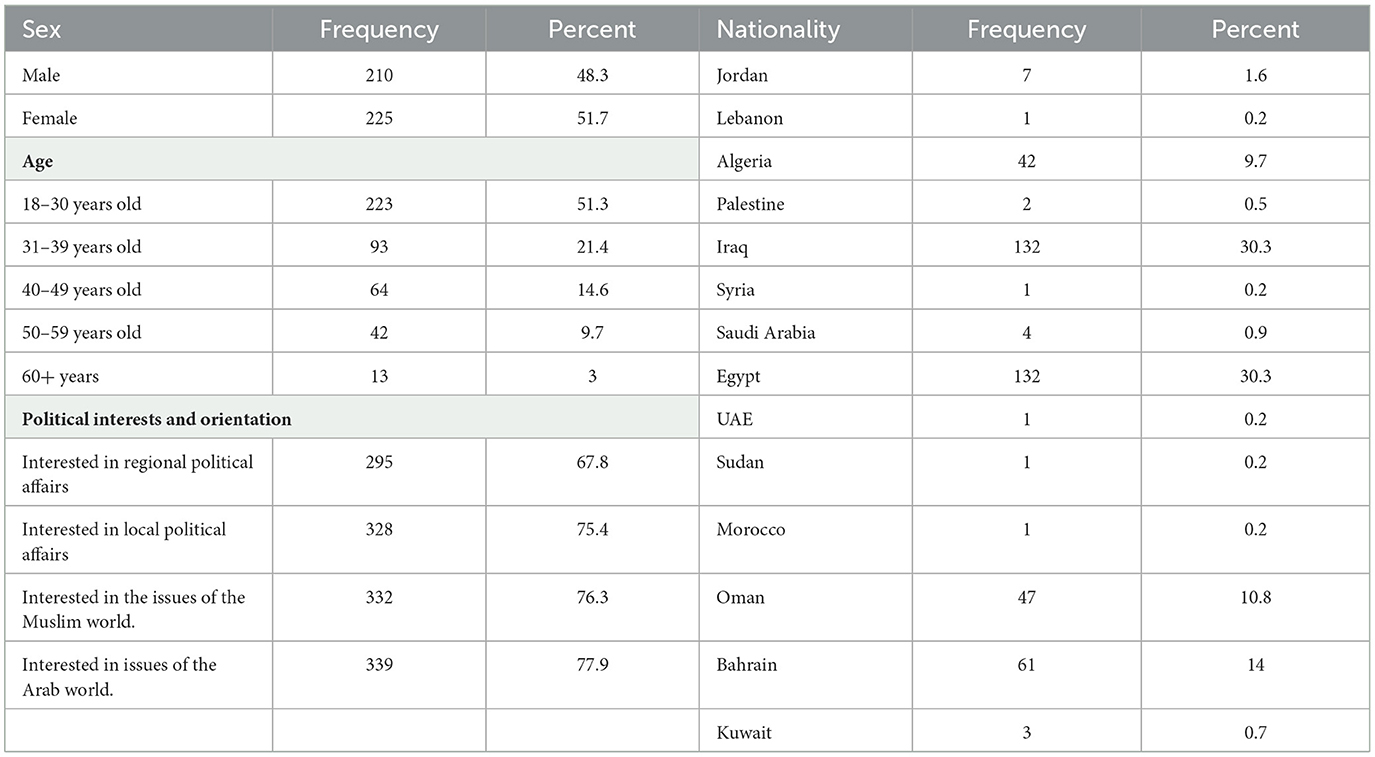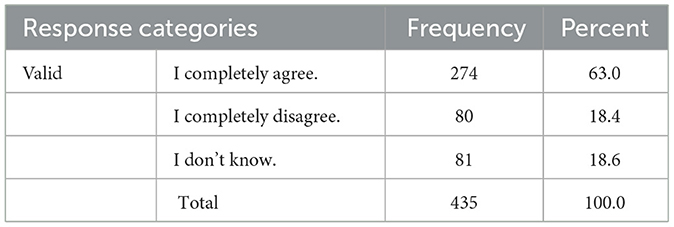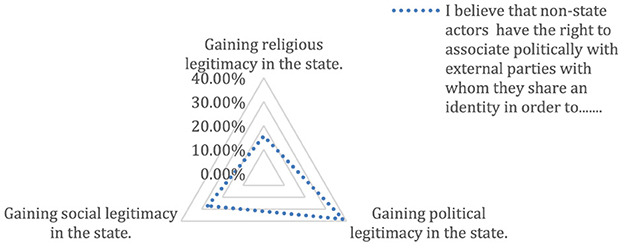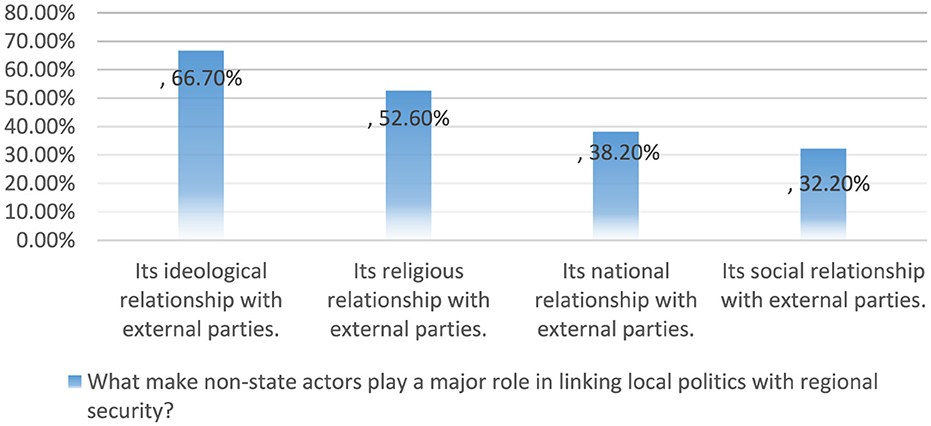- 1College of Administrative Sciences, Applied Science University, Manama, Bahrain
- 2Department of Geography, Sultan Qaboos University, Muscat, Oman
- 3National Defense College, Abu Dhabi, United Arab Emirates
- 4College of Political Science, University of Baghdad, Baghdad, Iraq
- 5Helwan University, Cairo, Egypt
This study investigates the role of identity as a critical factor in mediating the relationship between local and regional politics within the broader context of international relations (IR). While identity is frequently acknowledged as a catalyst for political instability and conflict, its function in fostering interdependence across political levels remains underexplored, particularly through empirical research. To address this gap, the study adopts a quantitative methodology, drawing on theories of identity politics and interdependence. A structured survey was administered to assess public perceptions of identity's influence on international engagement and its bridging role between domestic and regional political dynamics. The findings indicate that respondents identify several key mechanisms through which identity fosters interconnection: cross-border solidarity, state-building processes, political legitimacy and survival, identity discourse in foreign policy, and the influence of non-state actors. Notably, participants expressed concern that instrumentalizing identity in state-building poses security threats at various levels—local (37.2%), national (18.2%), international (11.7%), and regional (9%). The data also reveal that ideological divides between social movements and state authorities, as well as transnational alliances between non-state actors and foreign powers, undermine state legitimacy and stability. The study contributes to theoretical and empirical debates in IR by demonstrating how identity shapes political interactions across multiple governance levels. It emphasizes the importance of public perceptions in legitimizing political engagement and reveals how identity can simultaneously serve as a unifying and destabilizing force in regional and international contexts.
Introduction
The increasing complexity of global politics demands new theoretical frameworks that move beyond material power and institutional structures to account for the ideational forces shaping international relations (IR). Among these, identity1 stands out as a central—yet underexamined—factor in influencing how actors operate across local, regional, and international levels. While conventional approaches such as neorealism reduce state behavior to rational calculations of power and survival, they fail to capture the formative role identity plays in shaping interests, alliances, and legitimacy. In contrast, constructivism offers a compelling lens to study identity, as it foregrounds how social interactions and shared meanings generate political realities.
This study draws primarily on Wendt's (1999) constructivist framework, as articulated in Social Theory of International Politics, which reconceptualizes the international system as a product of socially constructed identities and norms. Wendt argues that “anarchy is what states make of it,” implying that the international order is not given but continually shaped through intersubjective understandings and identity-based interactions. Within this framework, identity is not just a consequence of state behavior, it is constitutive of it. In a complementary manner, Finnemore and Sikkink's theory of norm entrepreneurs (1998) shifts the analytical focus to individuals and networks that propagate norms, influencing political behavior through ideational and identity-driven appeals. These scholars highlight how identity is embedded not only in state structures but also in transnational movements and grassroots activism, making it a dynamic force in both policy and perception.2
Despite growing recognition of identity's relevance, a significant gap remains in empirical studies that explore how identity fosters multilevel interdependence,3 that is, the interconnectedness between local and regional political dynamics. Much of the literature focuses on identity as a driver of conflict or societal fragmentation, while neglecting its potential to serve as a bridge linking political actors, interests, and ideologies across borders. This oversight is particularly acute in regions like the Middle East and North Africa (MENA), where cross-border identities, religious affiliations, and ideological solidarities have long played a decisive role in shaping political alignments and contesting state authority.
This study seeks to fill that gap by examining the following research question: How does public perception conceptualize the role of identity in reinforcing multilevel interdependence in international relations? Grounded in constructivist theory, this research explores how individuals interpret identity's function in linking local communities4 with regional actors, including non-state entities, foreign powers, and transnational movements. By incorporating public opinion as a key analytical category, the study moves beyond elite-centric analyses and provides a grounded view of how identity influences political legitimacy, security, and cooperation at various levels.
The significance of this research lies in its dual contribution: theoretically, it integrates constructivist insights into identity, norms, and multilevel political dynamics; empirically, it offers original data through a cross-national survey of public perceptions in 14 countries. This approach not only deepens our understanding of identity as an ideational force but also highlights how popular narratives influence—and legitimize—interactions across political structures.
In doing so, the study challenges dominant paradigms that treat identity solely as a source of division. Instead, it presents identity as a potential vehicle for political connectivity, strategic engagement, and normative change across local and regional spheres. The next sections elaborate the theoretical framework, survey methodology, and findings that collectively illustrate identity's role in shaping the multilevel interdependence of international politics.
Interdependence in IR
Interdependence in international relations describes the extent of integration and collaboration among states and global actors. It plays an essential role in coordinating economic efforts to support shared political and security aims. Scholars such as Waltz and Wendt highlight that this mutual reliance spans both international and domestic arenas, where actors depend on each other for access to goods, services, and strategic benefits. Although cooperation often accompanies mutual dependence, mutual dependence does not necessarily indicate harmony; adversaries may rely on one another just as much as allies do (Waltz, 1979). No state operates in complete isolation—disengagement imposes substantial costs. According to Wendt, actors within such a system tend to avoid moves that might jeopardize their interconnected interests, even when they recognize the strategic advantages of these ties (Wendt, 1999).
In a similar vein, Waltz argues that reduced levels of interconnectedness hinder communication and increase the likelihood of unintended conflict (Waltz, 1979, p. 138). Other scholars observe that this complex web of reliance presents both risks and opportunities—while it can foster cooperation and promote peace, particularly among democratic states, it can also generate friction.
When such linkages span multiple structural levels involving diverse participants, clashing political agendas and differing values may exacerbate tensions.
From a Marxist standpoint, economic ideology significantly shapes relationships between local and global spheres, particularly in the context of class struggle (Kubálková and Cruickshank, 1989, p. 29–32). Marxists contend that dominant social and economic groups drive states as manifestations of underlying class structures, and their priorities shape foreign policy decisions (Knutsen, 2020, p. 174). This view contrasts with liberal perspectives, which often stress rational behavior and institutional incentives, while downplaying the influence of ideology and cultural identity.
Realist theorists, meanwhile, view mutual reliance as a source of unequal power relations. They argue that stronger actors can increase the vulnerability of weaker ones by making them dependent, thus heightening political pressure (Knutsen, 2020, p. 174; Viotti and Kauppi, 2014, p. 55–56). Such asymmetries fuel religious, cultural, or ideological competition, reinforcing patterns of dominance and systemic inequality.
The interaction between domestic and regional actors during crises further reveals how social competition embeds itself within political systems. (Cerny 2010, p. 29) notes that the evolving connection between local and global dynamics defines the modern political landscape rather than being an isolated trend. Similarly, multilevel interlinkages, spanning internal conditions and external influences—profoundly shape political and societal conflicts across all scales (Sondermann et al., 1970, p. 4).
As shown in Figure 1, mutual reliance represents a multidimensional phenomenon that both binds actors together and expose fault lines of conflict. Power disparities, ideological divisions, and structural complexities at local, regional, and global levels shape these dynamics. Understanding this intricate balance remains vital for interpreting the fluid interplay between cooperation and conflict in today's international relations.
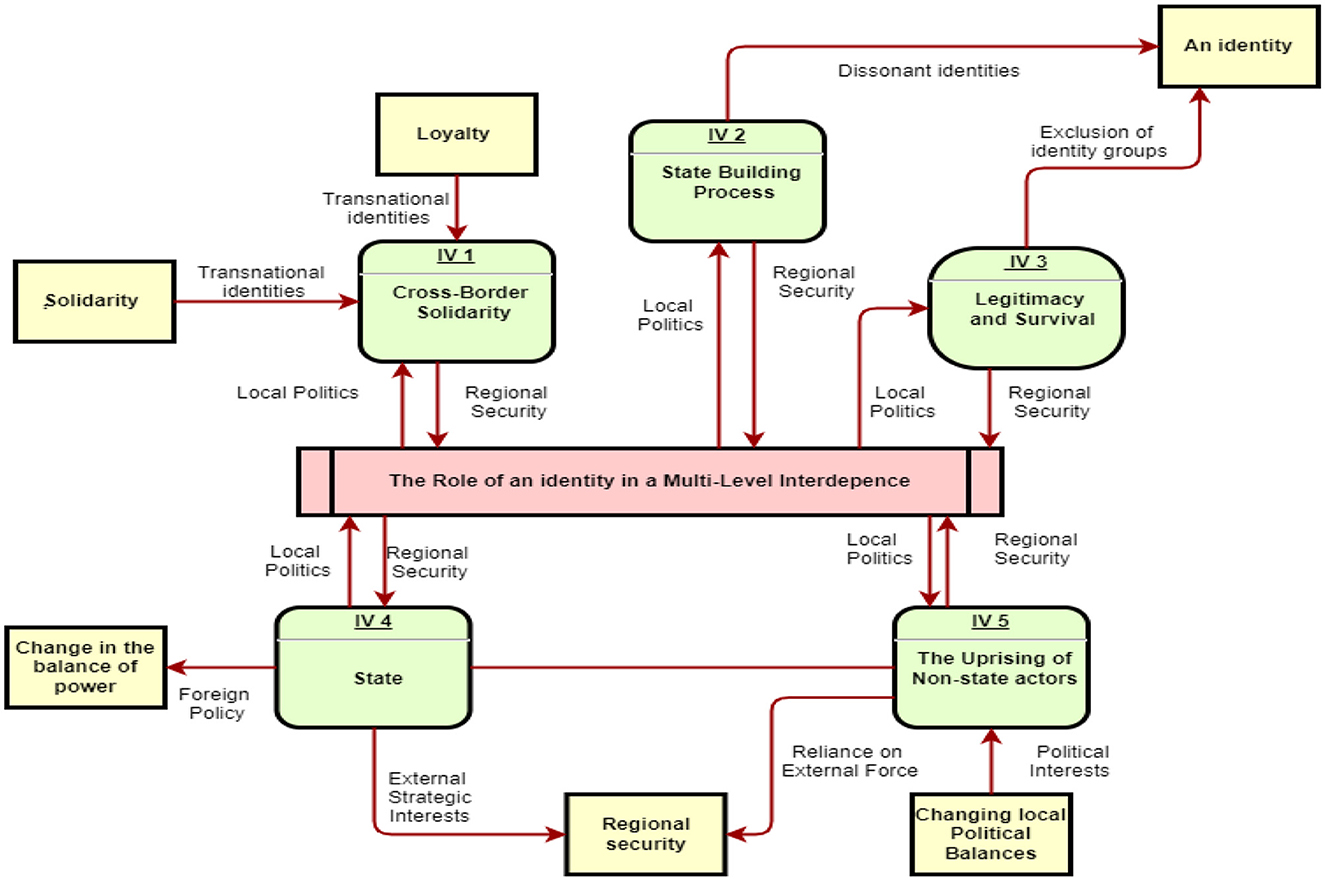
Figure 1. Visual representation of the primary dependent and independent variables. Source Created by the authors.
Social factors and interdependence
Social factors play a pivotal role in mediating interactions between state and non-state actors across various levels, forming the structural pattern that intricately links international, regional, and local dynamics as actors navigate power distributions and strive to secure their interests. Cerny further highlights how actors wield power differently depending on regional and local contexts, which adds complexity to interdependence (Cerny, 2010, p. 68).
In this context, constructivist theory offers a compelling framework for examining the interplay between identity and political behavior within local and regional spheres. Unlike realist and neorealist paradigms, which emphasize material capabilities and structural constraints, constructivism foregrounds ideational elements—such as identity, norms, and social constructs—as formative forces that shape the preferences and conduct of both state and non-state actors. Alexander Wendt encapsulates this view by asserting that “anarchy is what states make of it,” underscoring the idea that actors continuously construct the international system through shared understandings and interactions (Wendt, 1992, p. 396). Within this framework, identity actively constitutes the formation of interests, strategic alliances, and conflicts rather than remaining a passive backdrop.
This constructivist lens proves particularly valuable for analyzing global and regional interdependence because it allows scholars to understand how converging or diverging identities influence patterns of cooperation and competition beyond mere material considerations. For the purposes of this study, constructivism provides the tools to explore identity as a dynamic variable that strengthens the interconnectedness between local and regional political dynamics. By situating political actors within their social contexts, constructivist theory transcends the explanatory limitations of structuralist and realist models, probing the normative and historical roots of identity formation and their impact on political behavior. Moreover, it reveals how ideational factors—such as shared narratives and collective memory—can simultaneously foster cohesion and fragmentation within regional systems (Hopf, 1998; Wendt, 1999).
Despite the growing recognition of identity's importance, scholars have underexplored the mechanisms through which identity facilitates connections between political and security interactions across multiple levels. To address this gap, the present study proposes that multiple complex factors embedded within identity reinforce the nexus between local and regional political contexts. Accordingly, the study aims to identify the key identity factors that enhance interdependence within these political strata. To achieve this, we analyze the relationship between multilevel interdependence (as dependent variables) and five independent variables associated with identity dimensions.
Methodology
This study employed a quantitative approach using an online public survey. An advantage of online surveys is that they allow respondents to answer candidly, without fear of judgment. Google Forms was used to create and administer surveys. The survey employed a 3-point Likert scale and offered multiple-choice options. In certain cases, the respondents were permitted to select more than one answer.
The survey included eight demographic questions on age, education level, identity, gender, nationality, and membership in civil associations and political parties. The primary variables were assessed using 11 questions. Participants were asked about the role of identity in connecting local with regional politics. The questions in this research played a significant role as they were intricately linked to its aims and objectives, allowing for an analysis based on demographic categories. However, participants may have found it challenging to provide well-considered responses because they were asked about topics that they might not have contemplated prior to the survey, potentially resulting in inaccurate data.
Snowball sampling was used to select participants aged 18 years old. The questionnaire was accessible to the public for 60 days from February to March 2024.5 The survey encompassed 14 countries, including Arab nations, yielding 435 responses. The study population was substantial, thereby allowing the use of a conservative estimate of 100,000 for the study population size (Thompson, 1987, p. 42–46). In alignment with the statistical guidelines set forth by Steven K. Thompson, the sample size was deemed appropriate, as it represented 5% of the study population.
The equation is defined as follows: \(N\) represents the population size, \(z\) denotes the standard score ranging from 0.95 to 1.95, \(d\) is the margin of error set to 0.05, and \(P\) is the probability value, which is 0.50. Thompson's equation, when used for the study population, yielded an appropriate sample size of 1,454 respondents.
A key limitation of this study lies in the sample size. Based on Steven K. Thompson's sampling formula, a minimum of 1,454 participants was required to achieve statistical representativeness for a population estimated at 100,000, assuming a 95% confidence level and a 5% margin of error. However, the final dataset comprised only 435 valid responses. This shortfall is primarily attributed to the reliance on snowball sampling, a non-probability technique that inherently restricts the researcher's ability to control both the volume and demographic diversity of participants. The method was selected due to practical difficulties in accessing a comprehensive or randomized sampling frame across the 14 countries included in the study, many of which are Arab states.
Additionally, the data collection period was limited to 60 days, spanning February to March 2024. Given that participation was voluntary and recruitment depended on participant-driven referrals, response rates were variable and difficult to predict. These factors may have introduced selection bias and constrained the generalizability of the findings to the wider population. Nonetheless, the study offers meaningful insights into transnational attitudes and lays the groundwork for future research employing larger and more representative samples.
Table 1 showed that participants provided information on their age, political affiliation, sex, and social identity. It was found that 51.7% of the respondents were female, while 48.3% were male. Most respondents fell within the 18–30 years age range (51.3%), followed by those aged 31–39 years (21.4%).
In terms of methodological limitations, the number of survey participants was relatively small and drawn from a limited number of Arab countries, primarily due to the sensitivity of the political and social issues addressed by the key research variables. Nevertheless, the sample is suitable for analyzing participants' perceptions of identity's role in linking local and regional political interactions. Although it is well-established in IR scholarship that mass publics generally have limited knowledge and interest in international affairs (Knecht and Weatherford, 2006, p. 705–727), this study makes a valuable contribution by measuring public perceptions regarding the effects of identity within complex international relations contexts. Through respondents' views, we gain insight into whether identity plays a role in linking multi-level interactions in international relations. Furthermore, the study draws on public perceptions to identify the key factors that make identity an influential element in promoting multi-level interdependence.
Table 2 presents the internal consistency of the survey constructs as measured by Cronbach's alpha coefficients, which range from 0.256 to 0.674. These values indicate generally weak to moderate internal reliability. According to conventional benchmarks, alpha values below 0.6 suggest that some constructs may lack adequate reliability, potentially due to the limited number of items in certain scales or the conceptual heterogeneity of the measured constructs. Nonetheless, despite these limitations, the instrument provides valuable preliminary insights into the role of identity in linking local and regional political interactions. We recommend that future research improves the reliability of these measures by including additional items and conducting rigorous empirical validation.
Cross-border solidarity
Identity and ideology are a system of ideas that shapes how individuals perceive their existence and relationships. It encompasses aspects such as identity and religion, which can enhance social solidarity within a society (Thompson, 1986, p.44). Identity and ideological solidarity are based on a collective of ideas that are partly cohesive and aim to engage through behaviors that achieve accomplishments or maintain the group's survival or future (Waxman, 1978, p. 3).
The appeal of identity, along with religious and ideological factors, intensifies multilevel interdependencies in conflicts and political interactions at both regional and local levels. A plausible explanation for this interdependence is solidarity, based on ideology, religion, and identity among international actors and local entities at the community level (Sangiovanni and Viehoff, 2023).
In IR, identity plays a crucial role in reinforcing the interdependencies between non-state actors and authorities at local and regional levels. This phenomenon can be attributed to how identity and ideology promote interdependence between local social groups and foreign powers, fostering a sense of solidarity and ideological allegiance among political and religious leaders across nations (Darwich, 2021).
Figure 2 illustrated that, when participants were questioned about the role of identity in reinforcing ties between local and regional politics, many respondents indicated that identity enhanced loyalty (72.2%), interdependence (71.5%), and solidarity (48.5%) among non-state actors and external entities with a shared identity. Although some argued that the state's foreign decision-making process was not influenced by social identity but rather by rationality and pragmatism—and that social dimensions were used merely as tools to achieve foreign policy goals (Kahler, 1998, p. 919–941)—these statistical results were significant for decision-makers, as they emphasized the importance of identity in linking local and regional political interactions. In international relations, identity played a critical role in strengthening interdependencies among social identity groups at both local and regional levels. This occurred through social solidarity and loyalty, which posed potential threats to political stability at these levels.
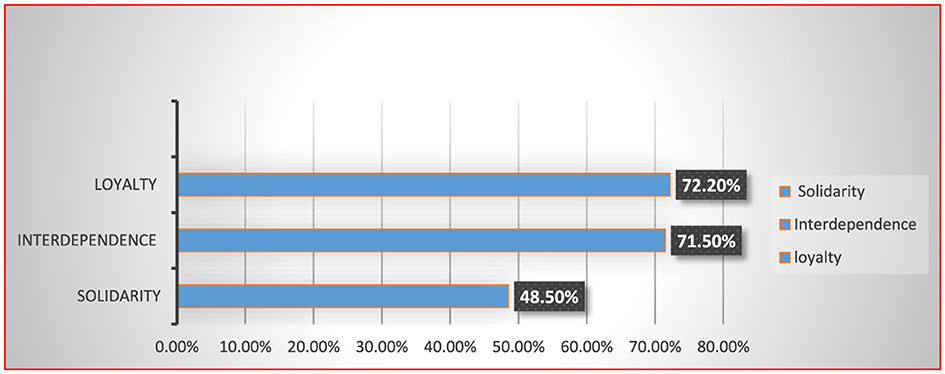
Figure 2. I envision identity as fostering... between non-state actors and external forces with which they share an identity.
In response to the question, “Do you think that the interdependence between non-state actors and external forces threatened society, the state, and the international system?”, a range of responses was elicited. As shown in Figure 3, very few participants believed that interdependence threatened the following security aspects: community (34.2%), state (28.7%), regional environment (21.4%), or international order (12.4%). This statistic was significant because it indicated that the effect of identity on regional and local security was substantial, particularly when identity allowed states to access the local interactions of other states by leveraging identity-based relationships with non-state actors to influence both communities and governments.
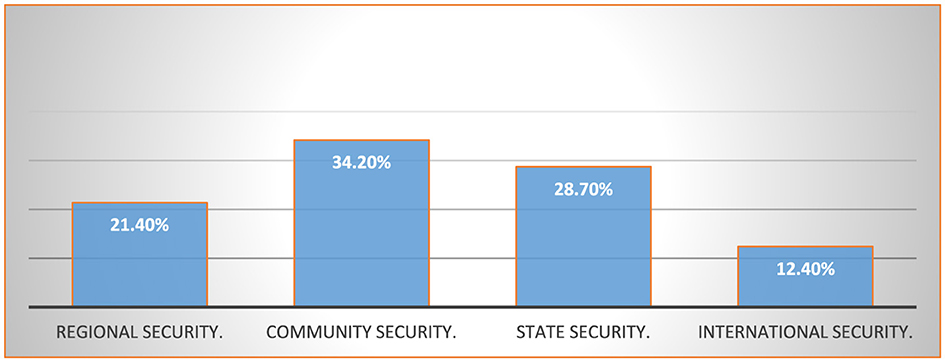
Figure 3. I imagine that the interdependence between a non-state actors and external forces threatens….
The principal objective of interdependence between regional stakeholders and non-state actors is to foster solidarity and social cohesion. These interactions seek to establish reciprocal dependencies in the political, economic, military, and social contexts. Religious and identity-based solidarity and loyalty have become dominant forces in the relationship between non-state actors and key countries in IR (Modongal, 2023). Communities provide support for geopolitical policies of actors with similar identities in other state-building processes.
State building
Understanding the process of constructing a state and its identity, along with the impact of social movements on the state's development in modern history, helps comprehend how social entities' identities have shaped the complex interactions between domestic and regional environments. While an identity might challenge the regime, the authority may adopt a contrasting identity at the constitutional level to secure the regime's legitimacy and survival, thereby influencing internal balance (Przeworski, 2023, p. 979–988). However, these complex interactions may have negative security and political repercussions on society, the state, and the regional environment.
Table 3 shows that nearly two-thirds of the participants (63%) agreed that excluding certain local non-state actors from the state-building process threatened community security. This exclusion allows other countries in the region to influence their internal affairs, whereas identity reinforces the interdependence of foreign states and non-state actors. Thus, identity can significantly affect state development, building and stability. This finding, while preliminary, suggests that a state may face challenges such as a constitutional vacuum, violence, and demonstrations due to the coexistence of numerous social groups. Political and identity contradictions between non-state actors and regimes can be viewed as one of the main factors affecting political stability in society and state identity.
As illustrated in Figure 4, 68% of respondents indicated that contradictions based on identity between non-state actors and political authorities had the potential to negatively impact political stability. In the same context, 45.5% of participants proposed that these multilevel interactions could affect social integration within the state. Notably, 40.2% of respondents stated that a dissonant identity could negatively influence a state's identity. When asked whether identity-based dissonance constituted a threat to national security, < 28% responded affirmatively. This finding implied that contradictory identities might contribute to societal division and pose threats to state sovereignty, particularly due to interference by regional or international powers seeking to protect the rights of minorities and marginalized social groups (Shrinkhal, 2021, p. 71–82).
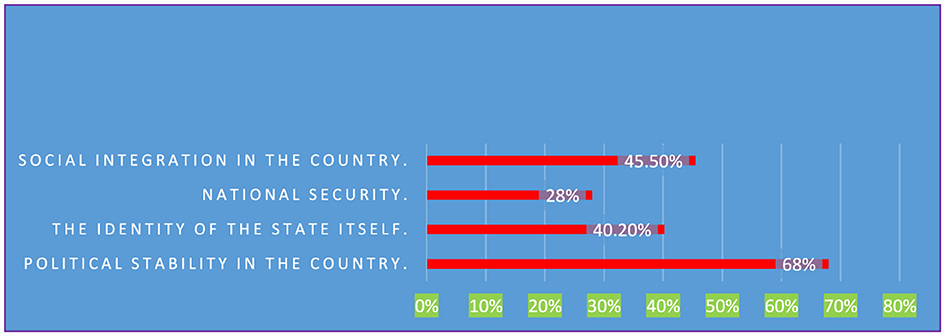
Figure 4. The contradictions on the basis of identity between a non-state actors and political authority may negatively affect….
The findings in Figure 5 showed that participants believed using identity as a tool in the statebuilding process threatened local community security (37.2%), national security (18.2%), international security (11.7%), and regional security (9%). While regimes often employed identity as a political instrument in state formation, ideological and political differences between social movements and governing authorities significantly influenced the political stability of the state. Transnational relationships between non-state actors and foreign states posed serious challenges to state-building. Foreign states heavily influenced local political affairs by providing financial, logistical, and political support to non-state actors. This support frequently targeted regimes perceived as illegitimate from ideological or social perspectives, potentially leading to a crisis of survival for the state, its authority, and its associated non-state actors.
Searching for legitimacy and survival
Recognizing the importance of non-state actors is not a new insight into international relations. As early as the 1970s, interdependence literature acknowledged that world politics was not exclusively the domain of states and their representatives (Stengel and Baumann, 2017, p. 5). However, non-state actors have recently received increased attention in the context of globalization and global governance (Stengel and Baumann, 2017, p. 5).
Some non-state actors seek to influence local actors and politics by aligning themselves with external non-state actors to enhance their legitimacy and survival. Because of these interactions at various levels, states can partially lose sovereignty and security, especially when local groups have strong correlations with foreign states who share similar identities. Non-state actors can be valuable allies; however, they can also hinder the implementation of state foreign policies or, in extreme cases, force great powers to adapt their foreign policies (Sondermann et al., 1970, p. 5). Sondermann et al. clarify that an increase in the level of interdependence creates political integration, which affects state stability and sovereignty (Sondermann et al., 1970, p. 4). Some countries struggle to control their sovereignty, because non-state actors have identities that differ from those of the state. Therefore, it is important to ask ourselves: what identity most enhances the interdependence between local and regional political levels?
The respondents were asked to identify which form of identity promoted solidarity between external actors and local groups. As shown in Table 4, more than half of the participants (53.1%) indicated that patriotism was the most important factor in fostering solidarity between local social entities and foreign states or non-state actors. Other significant responses included Islamism (37.9%), religious identity (37.9%), and ideology (34.3%). A key question that emerged was why patriotism fostered solidarity to a greater extent than other forms of identity. One possible explanation for this phenomenon was that, in many Arab states, patriotism was inextricably linked to Islamic and Arab identities. These overlapping identities reinforced solidarity between the Islamic and Arab worlds. However, identity also functioned as a double-edged sword—either facilitating integration among actors or threatening their legitimacy and survival.
Similarly, Sondermann et al. clarified that an increase in the level of interdependence creates political integration (Sondermann et al., 1970, p. 4). Political integration and solidarity between local and external actors could affect state legitimacy and survival, especially if there is dissonance between the identity of the state and non-state actors. In this context, a state may struggle to maintain sovereignty when local non-state actors hold ideologies that differ from those of that state. Conversely, a regime seeks to dominate political life by dividing political power among non-state actors based on their identity. This trans-state interaction can undermine the legitimacy of both the state and non-state actors.
Figure 6 revealed that more than one-third of the respondents (38.4%) believed that non-state actors had the right to associate politically with external parties with whom they shared an identity to gain political legitimacy within their homeland. Other motivations identified by respondents included the acquisition of religious legitimacy (15.6%) and social legitimacy (27.1%) within the state. These findings illustrated that multilevel interdependencies enhanced the legitimacy of local non-state actors at various levels, thereby contributing to the rise or survival of their political entities.
These statistics above indicate public awareness about competing visions of sovereign power and the role of ideologies in shaping the political perceptions of non-state actors, even though these elements ultimately frame the interdependence between actors at regional and domestic level. In the context of the present study, this process takes place through solidarity and cross-border loyalty to other sovereigns, based on religious and social values. These multi-level interactions have principally borne implications for the survival of regimes, the stability of society, state sovereignty and regime legitimacy. Therefore, a regime may consider some non-state actors to be disloyal to a state, due to their political and religious relations with other sovereign powers. In addition, Figure 6 demonstrates the extent to which a regime's lack of legitimacy, based on religious, social or political factors, can lead non-state actors to cooperate with external forces. Such non-state actors may likewise resort to regional powers as a source of financial and political assistance when confronted with illegitimate regimes, especially where religious and social ties exist.
Furthermore, Figure 7 illustrates that 38.4% of respondents believed that non-state actors had the right to communicate with external parties such as groups or states with whom they shared an identity to ensure their survival within a state. A minority of participants (26%) indicated that the primary reason non-state actors reached an external party such as foreign states was to enhance their political influence in their homeland.
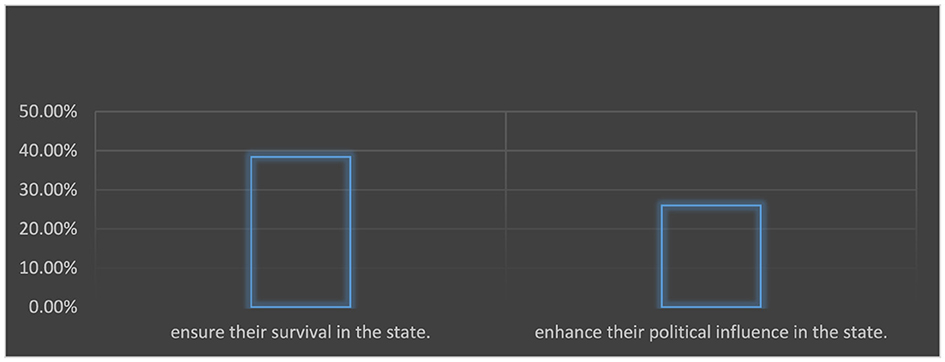
Figure 7. A non-state actors have the right to communicate with external parties with whom they share an identity in order to…
Overall, these statistics support the view that the public is aware to what extent the trans-state ideology and ethno-religion loyalty leads to a correlation between internal and external levels of structure. The public has perceptions that if the political environment includes different identities that lead subidentities to maintain their existence and survival through enhancing interdependence and solidarity with actors who share with him the same identities. Because of distributing the political power and institutions between non-state actors in a state, this may threaten state sovereignty, which shapes domestic stability dilemma. When political stability equation in a state established through identities quotas to maintain a regime, then a state would be involved in an internal stability problem.
The politics of identity in a state foreign policy discourse
In IR, identity is considered one of the main factors that contributed to political instability and societal fragmentation in many nations. The political landscape includes various religious and non-state actors forming alliances with similar groups across the region. Trans-state actors influence political interactions at multiple levels, creating a complex and interconnected environment. This complex interaction reinforces the interdependence between regional and local balances. Nevertheless, the relationship between a regime and non-state actors in a state may be influenced by the political balance and religious interference in the region (Mlambo, 2023). Consequently, political stability in governments, parliaments, and other political domains is shifting because of the evolving political balances and interactions between regional actors.
Regional structure considerably influences the role of social factors in the correlations between the different analytical structures. An identity tie between non-state actors and foreign states shapes the connections between regional countries and local actors within a state. The rivalry between countries is deeply intertwined with social and political interactions in local societies as these states use identity as a tool in their foreign policies (Burgess, 2021). Consequently, regional competition between countries can affect regime policies toward specific non-state actors.
Political leaders in states frequently offer political, military, and economic assistance to groups with shared identities to support their demands and rights against competing regimes in the region.
This identity competition between states can increase external intervention in the political affairs of other countries and help maintain their political systems by relying on social identity correlations.
Table 5 illustrates that half (50%) of the respondents indicated that major regional countries provide support to non-state actors in other countries with which they share an identity to influence political systems in neighboring countries. Additionally, the participants identified other reasons for this support, including the rise of competing regional powers (25.5%), influencing the balance of power between major countries in the region (29.2%), and affecting local political balances in regional countries (29.2%).
Given popular understandings of international politics, these statistics in Table 5 indicate that the public is aware of the balance of power among states at the regional level influences domestic politics in other countries. This view gives the impression that people have awareness that an identity significantly impacts both external and local politics, especially when regional states leverage identity relationships with local actors to influence a regime.
The emergence of non-state actors
Some scholars such as (Sondermann et al. 1970, p. 413) argue that state interdependence is not increasing, and non-state actors are intensifying their relationships. However, (Sondermann et al. 1970) widely accept that interdependence in IR focuses on states, which means that states remain the most important players even within interdependence. New realists assert that states play major roles in international relations and that relative power still influences their behavior (Cerny, 2010, p. 29–32).
In his book The Clash of Civilizations, Samuel Huntington argued that nation-states would continue to be primary actors in international relations. However, he proposed that non-state actors would become key players in international conflicts. Consequently, non-state actors can influence geopolitical interactions and challenge the dominance of the major players in regional contexts. Additionally, non-state actors connect regional interactions with domestic politics to achieve their goals (Wehrey et al., 2009, p. 7). It is essential to analyze the effect of non-state actors in strengthening multilevel social interdependencies between regional and local politics. These interdependencies can empower non-state actors and affect the state's political stability.
The data in Table 6 show that over one-third of the respondents (32.9%) believed that some non-state actors were more influential than certain countries in the region, particularly because they received support from major regional powers. In IR, non-state actors are often more powerful than in a few states as they receive various forms of support from key foreign states. Consequently, this statistic shows that public opinion has a perception that non-state actors can significantly influence the regional dynamics and its political stability (Ramirez, 2024, p. 7–12).

Table 6. I believe that some non-state actors are stronger than some countries in a region, especially since they receive support from major regional countries.
Moreover, non-state actors encourage political parties and groups in other countries to pursue political interests and rights by advocating for government reforms. This is particularly evident when there are similarities in political situations and identities between these groups (Cordesman, 1986, p. 32–90), which may shape public opinion trends positively or negatively toward non-state actors and political regime.
Public opinion imagines that non-state actors seek to exert influence over local actors by establishing connections between regional power dynamics and local balances through ideological and identity interdependences. As these interactions occur at various levels, states may experience a reduction in their sovereignty and security, particularly given the existence of strong ties between local groups and regional countries, which may make the masses see the state as a fragile entity because its sovereignty is limited (Ali et al., 2023, p. 442–459).
To identify the role of non-state actors in a multilevel structure, participants were asked what caused non-state actors to play a major role in linking local politics with regional dynamics. According to Figure 8, the participants' answers included ideological relationships with external actors (66.7%), religious relationships with external actors (52.6%), national relationships with external actors (38.2%), and social relationships with external actors (32.2%). These statistics showed that the public perceived ideology and religion as key factors that enabled non-state actors to connect domestic politics with the regional political environment. This assumption was important because, despite nation-states' efforts to strengthen national identities and weaken sub-identities such as religious beliefs, the public framed domestic crises and regional political events in terms of religion and ideology (Yilmaz and Morieson, 2023, p. 631). However, other motives also caused non-state actors to strengthen multilevel political interdependence. As (Durac 2015) stated:
“The category of violent non-state actors is broad, encompassing various groups that challenge the state's monopoly on the use of force. These include tribal and ethnic groups, warlords, drug traffickers, youth gangs, terrorists, militias, insurgents, and transnational terrorist organizations. Their motivations are diverse, ranging from profit-seeking to local concerns, rather than purely political or state-level ambitions” (Durac, 2015).
Based on Vincent Durac's opinion, in IR, the behavior of non-state actors significantly influences the interdependence between political interactions at both the local and regional levels. These non-state actors often rely on fears and political interest, especially during times of war and conflict, which negatively impacts regional stability.
Conclusion
The findings of this study highlight the public's perspective on the pivotal role of identity in strengthening connections between local and regional politics. These insights significantly enhance our understanding of how public perceptions shape the multilevel interdependencies between regional and local political arenas, framing interactions within both society and the state.
This research examines key factors that enable identity to underpin multilevel interdependence in international relations (IR), including state building, legitimacy and survival, the politics of identity in foreign policy discourse, the emergence of non-state actors, and cross-border solidarity.
Regarding cross-border solidarity, the study reveals that social solidarity among regional and non-state actors intensifies multilevel interdependencies across political structures, thereby reinforcing the legitimacy and survival of these actors. Policymakers should therefore prioritize fostering inclusive regional dialogues and cooperative frameworks that recognize shared identities, which can build trust and stability in volatile border regions.
In relation to state building, the research identifies social identity as a key source of national conflict and a critical link between domestic and external political dynamics. Current regional challenges, such as contested state legitimacy and identity-driven conflicts, necessitate policy approaches that integrate identity-sensitive governance and conflict resolution mechanisms.
Governments and regional organizations should implement identity-aware state-building initiatives that address both internal cohesion and external diplomatic relations.
Concerning legitimacy and survival, the public perceives social interdependence as crucial in connecting local politics with broader regional interactions, affecting actors' legitimacy and sovereignty. To enhance state stability, policymakers must incorporate public identity concerns into regional policy formulation, ensuring that governance structures reflect the social identities of communities. Such alignment can strengthen popular support for state sovereignty and legitimacy.
With respect to the politics of identity in state foreign policy, the findings indicate that political competition drives external interference by foreign actors leveraging identity ties within local power dynamics. This underscores the importance of safeguarding domestic political processes from foreign manipulation by promoting transparency and resilience in local institutions. Policy strategies should include monitoring foreign influence operations that exploit identity divisions and fostering inclusive political environments to mitigate such vulnerabilities.
Regarding the emergence of non-state actors, the study confirms that these actors leverage identity to influence local and regional security, often shaping a state's internal stability through ideological or religious affiliations linked to external entities. Policymakers need to develop targeted strategies to engage with or regulate non-state actors constructively, emphasizing dialogue and integration to prevent destabilizing cross-border influences.
Overall, this research offers IR scholars and policymakers a valuable framework for understanding public perceptions of identity as a force promoting multilevel interdependencies. Recognizing that while official foreign policy is crafted by leaders, public opinion significantly shapes the legitimacy and sustainability of these policies, it is essential to incorporate public identity orientations into policy design. Doing so can ensure greater popular support for foreign policy initiatives and enhance the legitimacy of states navigating complex regional dynamics.
Considering current regional developments—such as rising identity-based movements, external interventions, and shifting alliances, policymakers are encouraged to integrate these findings by adopting identity-aware, participatory approaches in regional governance and diplomacy to foster stability, legitimacy, and resilience.
Data availability statement
The raw data supporting the conclusions of this article will be made available by the authors, without undue reservation.
Ethics statement
Ethical approval was not required for the studies involving humans because as the studies were conducted in accordance with the local legislation and institutional requirements. Written informed consent for participation was not required from the participants or the participants' legal guardians/next of kin in accordance with the national legislation and institutional requirements.
Author contributions
RA: Conceptualization, Data curation, Formal analysis, Methodology, Project administration, Resources, Software, Supervision, Visualization, Writing – original draft, Writing – review & editing. KA-S: Conceptualization, Data curation, Formal analysis, Investigation, Methodology, Writing – original draft, Writing – review & editing. AB: Conceptualization, Resources, Supervision, Writing – review & editing. IA: Data curation, Methodology, Writing – original draft. NE: Conceptualization, Data curation, Writing – original draft.
Funding
The author(s) declare financial support was received for the research and/or publication of this article. The APC was partly funded by Applied Science University.
Conflict of interest
The authors declare that the research was conducted in the absence of any commercial or financial relationships that could be construed as a potential conflict of interest.
Generative AI statement
The author(s) declare that no Gen AI was used in the creation of this manuscript.
Publisher's note
All claims expressed in this article are solely those of the authors and do not necessarily represent those of their affiliated organizations, or those of the publisher, the editors and the reviewers. Any product that may be evaluated in this article, or claim that may be made by its manufacturer, is not guaranteed or endorsed by the publisher.
Footnotes
1. ^Identity is the set of beliefs, qualities, personality traits, expressions and values that characterize a group, person or state.
2. ^The importance of perception lies in its capacity to mediate between objective realities and subjective interpretations, thereby constructing political realities that guide actions. In the complex arena of international politics, where information is often incomplete or ambiguous, perception shapes how actors formulate interests, define enemies and allies, and choose courses of action. Misperceptions can lead to conflict escalation, while shared perceptions can foster cooperation and stability (Snyder and Diesing, 1977). Within this framework, perception acts as a bridge linking identity with behavior. Identities inform the lens through which actors perceive the world, and these perceptions, in turn, influence strategic calculations and policy decisions. By exploring how identity shapes perception, this research aims to contribute to a more nuanced understanding of how local and regional political actors interpret their interdependent contexts and how these interpretations translate into political behavior and security strategies. Therefore, integrating the analysis of perception into the study of identity and interdependence allows for a richer examination of the mechanisms driving political interaction across multiple levels. This approach not only enhances theoretical insights but also provides practical implications for anticipating political alignments and conflicts in a globalized world.
3. ^Interdependence means that mutual dependence. An actor is dependent on another one.
4. ^In this paper, we mean by domestic politics all activities, interactions and events related to national policy issues, and it also includes decisions and policies taken by decision-makers, parties and political groups, considering the reactions of public opinion and an interest group.
5. ^The researchers were committed to respect the human research participants' confidentiality, in agreement with the ethical policies for Applied Science University-Bahrain. The participants were informed that their identity would not be identifiable from the paper.
References
Ali, S., Zakir, M. H., Arif, M., and Hammad, S. (2023). The CPEC-sovereignty dilemma between prosperity and autonomy: an exploratory study. Pak. Islam. 3, 442–459.
Burgess, S. (2021). Regional security complexes and African foreign policies. J. Indo-Pac. Aff. 4, 65–92.
Cerny, P. G. (2010). Rethinking World Politics: A Theory of Transnational Neopluralism. Oxford: Oxford University Press.
Cordesman, A. H. (1986). The middle east and the cost of the politics of force. Middle East J. 40, 5–15.
Darwich, M. (2021). Foreign policy analysis and armed non-state actors in world politics: lessons from the Middle East. Foreign Policy Analysis 17:orab030. doi: 10.1093/fpa/orab030
Durac, V. (2015). “The role of non-state actors in Arab countries after the Arab uprisings,” in IEMed: Mediterranean Yearbook 2015. https://www.iemed.org/publication/the-role-of-non-state-actors-in-arab-countries-after-the-arab-uprisings/ (Retrieved July 10, 2025).
Finnemore, M., and Sikkink, K. (1998). International norm dynamics and political change. Int. Organ. 52, 887–917. doi: 10.1162/002081898550789
Hopf, T. (1998). The promise of constructivism in international relations theory. Int. Securi. 23, 171–200. doi: 10.1162/isec.23.1.171
Kahler, M. (1998). Rationality in international relations. Int. Organ. 52, 919–941. doi: 10.1162/002081898550680
Knecht, T., and Weatherford, M. S. (2006). Public opinion and foreign policy: the stages of presidential decision making. Int. Stud. Q. 50, 705–727. doi: 10.1111/j.1468-2478.2006.00421.x
Knutsen, T. L. (2020). A History of International Relations Theory (3rd Ed.). Manchester: Manchester University Press.
Kubálková, V., and Cruickshank, A. A. (1989). A Rambo come to judgement: Fred Halliday, Marxism and international Relations. Rev. Int. Stud. 15, 29–32. doi: 10.1017/S0260210500113075
Mlambo, V. H. (2023). Unravelling Africa's misgovernment: How state failures fuel the emergence of violent non-state actors: Selected case studies. Cogent Soc. Sci. 9:2228127. doi: 10.1080/23311886.2023.2228127
Modongal, S. (2023). The resurgence of religion in international relations: how theories can accommodate it?. Cogent Soc. Sci. 9:2241265. doi: 10.1080/23311886.2023.2241265
Przeworski, A. (2023). Formal models of authoritarian regimes: a critique. Perspect. Polit. 21, 979–988. doi: 10.1017/S1537592722002067
Ramirez, C. (2024). The role of non-state actors in conflict resolution: a comparative analysis of peacebuilding efforts in Colombia and Nepal. Stud. Soc. Sci. Human. 3, 7–12. doi: 10.56397/SSSH.2024.02.02
Sangiovanni, A., and Viehoff, J. (2023). “Solidarity in social and political philosophy,” in The Stanford Encyclopedia of Philosophy. Stanford: Stanford University.
Shrinkhal, R. (2021). “Indigenous sovereignty” and right to self-determination in international law: a critical appraisal. AlterNative: Int. J. Indig. Peoples 17, 71–82. doi: 10.1177/1177180121994681
Snyder, R. C., and Diesing, P. (1977). Conflict Among Nations: Bargaining, Decision Making, and System Structure in International Crises. Princeton University Press.
Sondermann, F. A., Olson, W. C., and McLellan, D. S. (1970). The Theory and Practice of International Relations.
Stengel, F. A., and Baumann, R. (2017). Non-state actors and foreign policy. Oxf. Res. Encyclopedia Polit. 5, 1–29. doi: 10.1093/acrefore/9780190228637.013.456
Thompson, S. K. (1987). Sample size for estimating multinomial proportions. Am. Stat. 41, 42–46. doi: 10.1080/00031305.1987.10475440
Viotti, P. R., and Kauppi, M. V. (2014). International Relations Theory. Vol. 5. Harlow: Pearson, 55–56.
Wehrey, F., Kaye, D. D., Watkins, J., Martini, J., Guffey, R. A., and Heim, J. L. (2009). Saudi-Iranian Relations Since the Fall of Saddam: Rivalry, Cooperation, and Implications for US Policy. Santa Monica, CA: Rand Corporation, 7.
Wendt, A. (1992). Levels of analysis vs. agents and structures: part III. Rev. Int. Stud. 18, 181–185.
Wendt, A. (1999). Social Theory of International Politics, Vol. 67. Cambridge: Cambridge University Press.
Keywords: social structure, interdependence, security, identity, international relations, public opinion
Citation: Alrasheed RA, Al-Shamli KAS, Benabdallah AK, Abed Al-Ameri IM and Elshorbagy N (2025) The role of identity in a multilevel interdependence in international relations: exploring popular understandings of international politics. Front. Polit. Sci. 7:1595969. doi: 10.3389/fpos.2025.1595969
Received: 21 March 2025; Accepted: 08 July 2025;
Published: 22 August 2025.
Edited by:
Adel Al-Hawatmeh, Lusail University, QatarReviewed by:
Lubna Naser Eddin, Lusail University, QatarMohamed Ourya, Lusail University, Qatar
Zuzanna Halina Sielska, Institute of Central and Eastern Europe Three Seas Foundation, Poland
Copyright © 2025 Alrasheed, Al-Shamli, Benabdallah, Abed Al-Ameri and Elshorbagy. This is an open-access article distributed under the terms of the Creative Commons Attribution License (CC BY). The use, distribution or reproduction in other forums is permitted, provided the original author(s) and the copyright owner(s) are credited and that the original publication in this journal is cited, in accordance with accepted academic practice. No use, distribution or reproduction is permitted which does not comply with these terms.
*Correspondence: Rashed Ahmed Alrasheed, cmFzaGVkLmlzbWFlZWxAYXN1LmVkdS5iaA==
†ORCID: Rashed Ahmed Alrasheed orcid.org/0000-0001-9945-1407
Khalid Amur Salim Al-Shamli orcid.org/0009-0009-9760-9798
Nahla Elshorbagy orcid.org/0009-0005-9796-2373
 Rashed Ahmed Alrasheed
Rashed Ahmed Alrasheed Khalid Amur Salim Al-Shamli2†
Khalid Amur Salim Al-Shamli2† Aicha Kada Benabdallah
Aicha Kada Benabdallah Nahla Elshorbagy
Nahla Elshorbagy